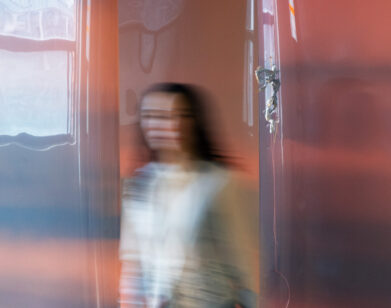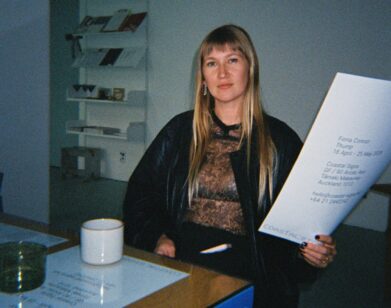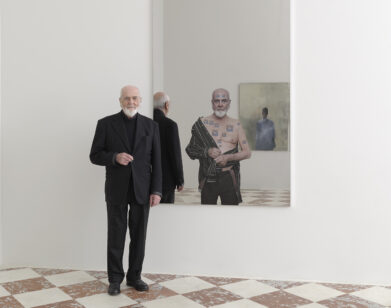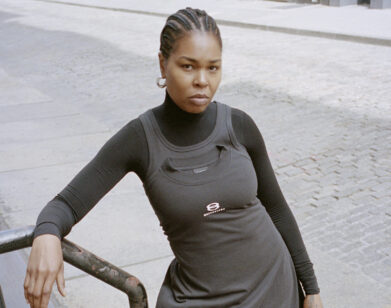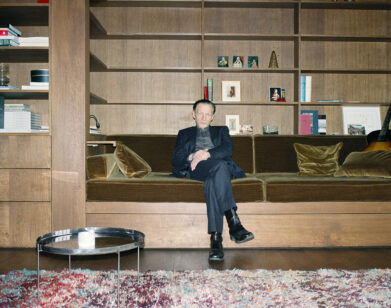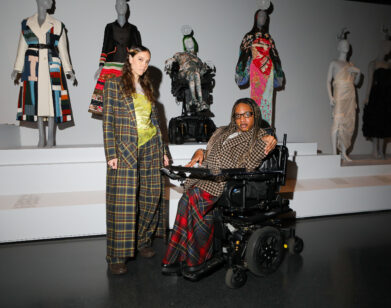Donald Judd and Frank Stella DebateSculpture, Space, and the Art of A Stupid Idea
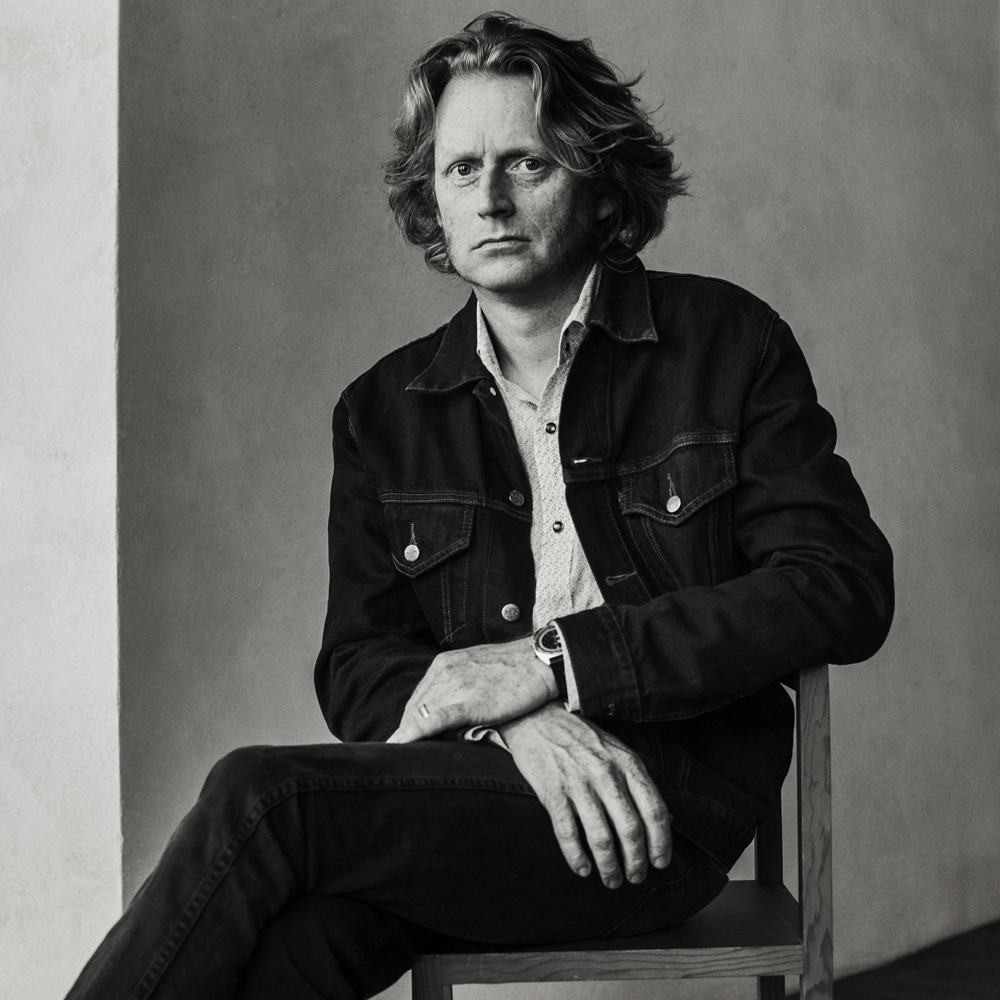
Flavin Judd. Photo by Sebastian Kim.
Essays, written, re-written, labored and belabored over are the thirteen course meals of thinking. Interviews are the sardines and crackers equivalent—fast and on the fly. While you can learn a lot from the meticulously produced essay, there is also something to be said for the messiness of the interview, even if edited itself afterwards. It’s a form that is in one sense truer to life but also more fraught with mistakes, misspoken words and hiccups. But in there, in the good interview, you can catch the electricity of a good conversation, where things are made and visual ideas verbalized, sometimes for the first time.
Donald Judd and Barbara Rose studied together at Columbia and knew each other well. During that time, Don and my mother Julie had moved to 19th Street, and it was a situation of friends getting together to talk about what was important to each other—their work. This is an excerpt from a longer interview, between Don, Barbara, and Frank Stella, that is itself part of the newly published Donald Judd Interviews—1,000 pages of discussion and ideas, hiccups included. —FLAVIN JUDD
———
BARBARA ROSE: We are going to resume our interview with Mickey the Dummy. [Laughter.] Would you tell us what your opinion of the Oblomov theory of your painting is? That is, that it’s the product of intense feelings of ennui and anomie?
FRANK STELLA: I just try to do the best job that I can to make Leo [Castelli] and you and all the people out there happy. [Laughter] And Ed Sullivan, too.
ROSE: Well, since you reneged on your promise to quit painting at the age of twenty-five, do you feel that many people were disappointed by the fact that you didn’t quit?
STELLA: Yes, I think my failure to not continue painting has disappointed a lot of people.
ROSE: On what did you base your original decision to quit painting?
STELLA: I had done enough painting. [Break in recording]
ROSE: You said that your work is not sculpture. If it isn’t sculpture, what is it?
DONALD JUDD: I don’t know what it is, and I don’t feel that I have to give it a title. So I don’t feel required to say what it is.
ROSE: Well, why don’t you feel it’s sculpture? What is it that differentiates it from sculpture?
JUDD: Because of the generally figurative organization of sculpture, sort of the core structure and the chronically composed nature of sculpture.
ROSE: In other words, the main difference between your work and sculpture is that you feel that your work is not composed?
JUDD: Yeah, not composed and not arranged on a central core.
ROSE: Well, you said “figurative”; do you mean that you feel that sculpture in the past has always been figurative?
JUDD: Yeah.
ROSE: All of it?
JUDD: Yeah.
ROSE: How about constructivist sculpture? Do you feel that constructivist sculpture is essentially figurative, too?
JUDD: Yeah.
STELLA: What’s the core in a plexiglass [Antoine] Pevsner, or something like that?
JUDD: Usually it’s composed in some way. One of them, for example, crosses on an X shape, so that’s still like a piece of sculpture on a pedestal, with sort of a central axis or whatever.
STELLA: What about something like David Smith’s “gate” pieces?
JUDD: Well, those are pretty recent. I haven’t seen them, and I haven’t thought about them that much. That might not be, but most of Smith’s work is decidedly figurative.
STELLA: Right. But these are based on something like a portal.
JUDD: Yeah. Well, they might be something else.
ROSE: You feel that your work is not axial, in other words? It’s not oriented on an axis? Well, obviously, it’s not.
JUDD: I guess not on that kind of axis, anyway.
ROSE: If your work isn’t composed, how do you arrive at it?
JUDD: Full blown in the middle of the night. [Laughter]
ROSE: How do you arrive at the conception if it’s not composed?
JUDD: It’s not composed in the sense that you try to arrange the parts a great deal in relation to one another or play with the parts in the process of making the thing. What Frank said the other day on the television—the correctional idea phrase was nice.
ROSE: What do you mean?
JUDD: Frank said he didn’t want to do correctional painting, which was nice. That is, you’re always involved in getting the rest of the painting up to something you like and making changes and adjusting everything, and finally you get everything adjusted. Which is a real pain in the neck.
ROSE: In other words, you don’t want to make any adjustments?
JUDD: No, I don’t see why you should make any adjustments.
STELLA: What I mean is that the adjustments are totally in terms of the final results. In other words, the adjustments you make are when you begin with the piece: the four boxes are adjusted, but after that, there’s just one adjustment.
JUDD: You figure it all out ahead.
STELLA: You don’t correct it, at least, in working. Well, you might correct it with the next piece. In other words, if you felt that the intervals were too wide, then you would—would that be a correction, or a different piece? I mean, you could correct it by doing another piece.
JUDD: I suppose it would be a correction. That stack that Henry [Geldzahler] bought is an inch further out from the wall—it sticks out an inch further than the first set that I made. So I thought it didn’t stick out just quite enough.
ROSE: Do you think of each piece as a correction, for example, of the piece that’s gone before, or an improvement in some way?
JUDD: No, because I can’t afford to do a number of pieces that are like one another.
ROSE: But I mean, do you analyze, for example, the last pieces you’ve done and try to make modifications in the next series?
JUDD: Not so much. They tend to be kind of separate things.
ROSE: Then, in other words, you don’t look at your work critically?
JUDD: Well, no—[Laughter]
ROSE: Well, why would you change a mode of working? I mean, why would you make a new set of decisions?
JUDD: The pieces are rather different from one another, so that you can’t just build another piece that’s a correction of a previous piece.
ROSE: No, I don’t mean a specific correction. But, for example, are you never dissatisfied with what you’ve done? And if you are dissatisfied, then do you try to make something that will be more satisfactory?
JUDD: I suppose so, but I’m not so dissatisfied lately. [Laughter] The change sort of takes care of itself. The change from the wooden pieces, which now look kind of foreign to me, to the present pieces took place without any particular anxiety over the first case.
ROSE: You’re making it sound very mystical. I mean, you never crystallize your thoughts about these matters?
JUDD: Yeah, but it’s not a case of enormous worry or anything. I decided that the paint on the wood had a certain kind of generality which still had something to do with the quality of painting, say Newman’s big surfaces or something, and that again was something I didn’t want, and I saw a way how I could get rid of it by using actual materials.
ROSE: And you don’t feel that applied color, for example, gives that same effect that the painted wood gave?
JUDD: No, because it’s such a peculiar kind of color, and there’s not that much of it, either.
ROSE: In other words, you feel your color now is no longer at all related to painting color?
JUDD: Well, I wouldn’t want to say that absolutely, but there’s a certain austerity that a big surface painted one color and a particular texture of cotton canvas and oil paint on it and so forth has. A particular kind of quality which I can’t really pin down.
ROSE: Yeah, which wood would have more than metal?
JUDD: Yeah, and when you paint over the wood, it’s still somewhat that same quality, because it sinks in a bit. It comes out matte. And as nice as that is, that’s I think too easy a kind of generality to get hold of now.
STELLA: To get back to the noncomposing idea: if you take, say, the piece with the four boxes and the blue channel running across in front of it, how do you manage to deal with that in noncompositional terms? For example, from the head-on view particularly, when you have the bar going across the four boxes, you have the proportion of the channel to the surface of the box, for one thing, which is a relationship that has to be worked out in some kind of way, plus you have the thing of the contrasting surfaces; you have a color problem. You have essentially a kind of blue and silver, or blue and galvanized metal. I mean, in spite of the fact that the organization may be simpler than most kinds of common thinking about composition, or organization, or whatever you want to call it, as far as making sculpture and painting goes, you’re still dealing with that same basic problem, and you have to make it convince you it will work out in some kind of way. You’re dealing with that kind of problem. So how is that noncomposing?
JUDD: Well, to some extent, it still is.
ROSE: Yeah, but essentially what you’re getting at is that the composition is nonrelational.
JUDD: The thing is that it’s primarily a whole, and it’s not so easily broken down into parts. Now, that is the main thing all along.
STELLA: Well, all right. Are you saying that because you give yourself pretty much a given unit—in other words, the very fact that you’re working from standard units, because the channel comes in certain sizes, right?
JUDD: Yeah.
STELLA: So you have a lot of decisions made for you. If you have such and such a size channel, or choices of channel, then you’re going to use them, and then, roughly, the choice of the boxes that you’re going to build for it are really well decided, in a way. In other words, it’ll be relatively easy to find a size that’ll go for each width channel.
JUDD: Actually, I had the channel, having gotten a piece on Canal Street some time ago. I cut out the face of the boxes in paper, and for a long time I juggled the face of the size of the boxes. [Laughter] They were hanging down.
ROSE: But you begin usually with a sketch, right?
JUDD: No, usually sketches are sort of after the fact.
ROSE: You mean you just carry these ideas in your head?
JUDD: Sketches aren’t necessary. They don’t tell me much about it.
ROSE: Yeah, but how do you decide to produce a piece?
JUDD: The ones that feel right. Same old story.
ROSE: Yeah, I know, but I mean, you just carry these around in your head, until one day, you call up and you have it done?
JUDD: One day I get the money to have it done.
ROSE: Oh, but you don’t put down your ideas in any notational form?
JUDD: Yeah, sometimes I put them down just to record the idea.
STELLA: Do any pieces or ideas seem really necessary or have priority? Do you ever get involved in a piece you feel you have to get through?
JUDD: Well, I obviously tend to do the pieces I like best and am surest of.
ROSE: In other words, you get a certain number of ideas and then some develop priority, because you don’t build them all, obviously.
JUDD: Well, some seem like a sure thing, better ideas. Often, it’s ones I’m sure of against ones that seem to be a considerable gamble. Because obviously you can’t afford to lose $500 to $700 on a stupid idea.
ROSE: Why? What would be a gamble as opposed to a sure thing? I mean, what would be the difference?
JUDD: Well, some particular form that didn’t feel quite right but might be—I might think interesting, you know.
STELLA: Say if I were a wealthy patron and you have a series of ideas for, say, your next group of work that you’re going to do, and in the normal course of events you’re going to be able to build—you’re going to get the money in a fairly normal way as a result of working and whatnot, and you’re going to build those pieces. And I come along as Patron X and say I’ll match that amount of money and whatever money you need to build only the bad ideas, only the gambles, only the things you’re unsure of. Would it be interesting to you to see the body of work of the ideas with less risk against the ideas that have the maximum risk? I mean, do you think anything like that can change your thinking?
ROSE: Why are you thinking of these half-assed questions?
STELLA: You don’t think that’s a good question? No? All right. Go ahead.
ROSE: No, answer it if you’ve got an answer to that.
JUDD: No, it divides it up into two categories which I’m not especially interested in putting one against the other. The pieces I’m pretty sure of always seem pretty risky, anyway. So it’s not exactly such a safe bet. I thought for sure that show didn’t mean anything to anybody, and me included, when I put it up.
ROSE: So, there’s a certain degree of surprise until you actually see the things manufactured.
JUDD: Two of those pieces I hadn’t seen on the wall before.
ROSE: When you actually see them installed, then, there’s a certain degree of surprise? I mean, you really only know if they’re successful once you’ve seen them installed?
JUDD: Right. Yeah. And sometimes I’m not sure for a while either.
ROSE: So, in other words, your ability to visualize is very important—how accurately you can visualize, let me put it that way.
JUDD: Yeah.
ROSE: Okay. You’ve so far differentiated your work from conventional sculpture by saying it’s not involved in composition, or not involved in conventional composition, at any rate.
JUDD: It’s involved in proportion. That’s what Frank’s talking about, certainly.
ROSE: What, then, are the main considerations in your sculpture?
JUDD: Getting the size right is obviously very important. And I suppose you could call it composition in the sense that you juggle an area in a painting. The only thing I’m juggling—well, you can call it one proportion, or you can call it—
ROSE: Do you think proportion is the primary element involved? Relationships?
JUDD: Yeah. Just what size it is is highly important to me.
ROSE: How about materials? Do you think much about materials and color?
JUDD: Yeah, materials and color, what size it is.
STELLA: So, it’s sort of like architectural composition rather than, say, painting or sculptural composition. Somehow it involves more generalities and is less kind of concerned with specific details, in the sense that architectural composition has to deal with texture, with materials, but only in a way that it fits into the whole and how it relates to the space – whereas textural concerns in, say, sculpture, and particularly bad sculpture, get to be overly artistic, overly involved with details like expression and their own tactile values and their own aesthetic values. In other words, the aesthetics of a kind of bronze patina is a little different from the idea of, say, the way Mies [van der Rohe] wants bronze to be used, bronze plaques and bronze siding or a kind of bronze decoration to be used in something like the Seagram Building.
ROSE: Do you agree with that?
JUDD: It’s a long question. [Laughter]
ROSE: Well, I mean, essentially, do you think that your considerations or method is closer to architecture than sculpture?
JUDD: Yeah, obviously, it’s something like architecture. More like architecture than like previous sculpture. But I also think the decisions are specific. It’s specific, which material you choose.
ROSE: But you definitely feel different materials give different qualities? You don’t feel neutrally toward your material?
JUDD: No. Choosing to do the stainless steel took some thinking, because I’m sort of wary of stainless being a pretty elegant material, you know.
ROSE: Well, I think that’s a fairly elegant piece.
STELLA: Maybe it’s not fair to characterize a more traditional sculpture in this way, but, say, if a traditional sculptor wants to get some kind of expressive quality out of the materials—in other words, if stainless steel is used by, say, Brancusi, or maybe Rivera, or somebody like that, they want the beauty of the stainless steel. But if you are presented with the problem of stainless steel, you are worrying about how it can use its own properties to work in with your organizational ideas in this sort of overall point of the piece, the overall way of the piece. In other words, you don’t take your cue from the materials, but you want the materials to do more of what you want it to do.
JUDD: Yeah, but would that be any different from Brancusi? Or anyone else? You’re choosing materials because they produce a certain quality.
STELLA: Well, of course, but they basically molded it; they always molded the material, and David Smith scars it. And actually, in a way, you really let it alone more.
JUDD: But it’s still serving my purpose, though, all the same.
STELLA: Yeah. Right.
JUDD: And, you know, you’re using a quality that it has. I like its qualities better than anything I could do to it, anyway.
ROSE: Okay. Can I ask a few questions? Thank you.
JUDD: He’s not so dumb. Mickey isn’t dumb. [Laughter]
ROSE: Anyway, do you feel your work is related to painting in any way?
STELLA: Oh, what a boring question. [Laughter]
JUDD: Yeah, to some extent. I mean, obviously, it’s related to painting and to so-called sculpture and so forth. I’m not saying it’s brand-new and divorced—it’s connected to paintings—
ROSE: Well, my feeling as I’ve watched its evolution is that it evolved out of a criticism of painting.
JUDD: I guess so, but it’s better than painting.
ROSE: On what grounds?
JUDD: Well, in the first place, I couldn’t think of anything I could do with it that I wanted to do with it. So primarily on personal grounds. But after that, that it was a rectangle, that it was parallel to the wall, and that it was almost unavoidably illusionistic, and that none of the color or materials could be specific enough. There wasn’t much you could do inside of the rectangle because everything had to relate to it; otherwise you’d break it up too much. So you didn’t have many choices to work with. It seemed kind of contemplative, splayed out against the wall like that. I didn’t like that.
ROSE: You don’t like the idea of your work being interpreted as objects for contemplation?
JUDD: No, I guess not. Painting seemed kind of passive—
ROSE: Uh-huh.
STELLA: It’s the easiest thing.
ROSE: Do you see any problems in—well, using this work? I mean, it’s too large, really, for most people’s apartments. Is it intended for private collections? Or what is it intended for? How is it intended to be seen?
JUDD: It’s just intended to get done, that’s all.
ROSE: You never think, in other words, about the context in which it might be shown? Inside? Outside? Museums? Apartments?
JUDD: Not too much, because I don’t think I have much control over it. Therefore, it’s not a very interesting problem. I’d think about it a lot if I could control where it was going to be and could do something about where it was going to be.
ROSE: But you must be aware that it doesn’t fit into any of the contexts that are provided for collecting works of art at this point. Doesn’t that ever occur to you?
JUDD: No, what can you do about it?
STELLA: Write letters?
JUDD: [Laughter] You know, if that’s what I want to do, that’s all you can do. It doesn’t happen to be especially saleable or—
ROSE: Well, ideally, where do you think it should go? I mean, where do you think it should be placed, suppose you did have some control?
JUDD: Ideally, I’d like to build the architecture for it as well as—
ROSE: Ah! [Hums a tune] In other words, you visualize it in an architectural context?
JUDD: Well, everything is in an architectural context. It’s inside or outside, other than the high plains.
ROSE: All right. [Laughter]
STELLA: I want to ask one small last question. You use a negative sort of inflection in speaking about illusionistic space in painting. Why is it a negative proposition? For example, let’s say I allow a negative thing toward traditional naturalistic illusionism. But what would be the matter with, say, a good workable, abstract, illusionistic space, say [Jules] Olitski, or Bauhaus, Kandinsky?
JUDD: Because I think it’s still illusionistic in the same sense that the old naturalistic illusionism is illusionistic. I think it’s just one thing. There’s just less of it now than there was before. Essentially, it’s the same sort of phenomenon.
ROSE: As long as it suggests any kind of depth, Frank, it’s illusionistic.
JUDD: Which has objectionable qualities.
STELLA: Abstract illusionistic space, even though it’s the same kind of depth, it’s really not the same kind. For one thing, it’s shallower; and for two, when you don’t have the implication of a horizon line, you have a different kind of illusionistic space. The classic illusionism in the West is like looking out the window, right? When you look out the window you see the ground line, you have the trees, you have the light and dark, you have the top and bottom and all that—
JUDD: You have things one in front of the other.
STELLA: Right. But you look up, say, and you don’t look out the window. Say you’re standing in the middle of a meadow, and again you have the same kind of illusionism, but if you look straight up—and the problem of the horizon is not there on the picture plane if you’re looking straight up – then you have the infinite, but it’s still naturalistic illusionistic space, or the way we see.
JUDD: Mm-hmm.
STELLA: So it’s still a different kind of space. It’s a new abstract illusionistic space in, say, Olitski and in some of the things suggested in Kandinsky, which was obviously oriented toward a kind of stargazing—
JUDD: You really talk fast.
STELLA: —and that’s different.

